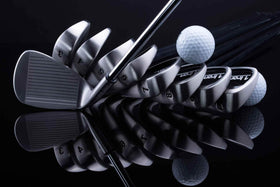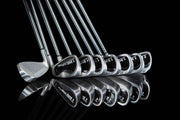Golf Club Fitting Myth
by David Lake
Terms like 1″ over “standard” or lie angles being 1º or 2º upright or flat from “standard” have no meaning whatsoever. The reason is that there is no standardization in the golf industry as to club length, loft angles, or lie angles and these “standards” vary widely between manufacturers. Unfortunately, the vast majority of pro-shops and custom club-fitters still fit golfers based upon these “standards” with the result being an improper fitting. For example: It is typical for a custom club-fitter to perform a dynamic fitting session in which the golfer hits balls off of a board using a “standard” fitting iron. At impact the board will leave a mark on the sole of the fitting iron and from this the club-maker will determine whether the lie angles of the golfer’s clubs need to be adjusted upright or flat from “standard”. The fallacies of this type of fitting include the fact that club length is not taken into consideration nor the obvious fact that there are no standards as to lie angles in the first place. There is also a major limitation inherent in dynamic fitting in that, generally speaking, no golfer has ever played with golf clubs that fit them properly and have, consequently, developed poor swings and swing postures as a result (this is the reason for the many unorthodox and sometimes amusing swings you see on the golf course). Therefore, if a golfer gets dynamically fitted for golf clubs using the same poor swing and swing posture that they developed using their old ill-fitting golf clubs the result will be new ill-fitting golf clubs.
Studies in sports physiology have shown that there is an ideal swing posture and swing plane that produces the optimum in power/control for all golfers regardless of height, build, sex, or age and which is the basis for the One Iron Golf fitting model. This is the basis for single length irons and this ideal swing posture and swing plane is achieved through the use of a specific club-head lie angle (63.5º for irons); and a proper fitting can only be achieved by fitting this lie angle to the individual golfer through the adjustment of club length based upon the golfer’s W-T-F measurement. Therefore, it is safe to say that if you own a set of golf clubs purchased “off the rack” they do not fit you and will never help you to improve your game. The same can also be said of custom fit “standard” golf clubs whose lie angles change from club to club with no consideration given to the ideal lie angle or properly fitted club length.
In the One Iron Golf fitting model proper club length in relation to the ideal club-head lie angle is based upon a golfer’s wrist-to-floor (W-T-F) measurement. The reason that the W-T-F measurement should be used to determine the correct club length in relation to the club-head lie angle is due to the trigonometric relationships involved. By using high-speed photography the distance from a golfer’s left (R/H golfer) wrist-crease (which is in line with the butt end of the golf club) to the ground at impact during a swing can be accurately measured. Using the data collected from hundreds of these measurements we found there to be a mathematical correlation (non-linear) between a golfer’s W-T-F measurement while standing at strict attention and their wrist-to-ground distance at impact (assuming the ideal swing plane and swing posture). Based upon this relationship we developed a formula to translate the W-T-F measurement into the wrist-to-ground distance which we use in the first step of our fitting model. Once the wrist-to-ground distance has been calculated and since we know the lie angle of the club-head, we use a modified trigonometry formula (an imaginary line drawn from the butt-end of the golf club at impact to the ground forms one side of a right triangle) to calculate the proper club length or the hypotenuse of the right triangle. I use the term modified trigonometry formula because other factors need to be taken into consideration such as shaft deflection and so forth.
Unlike standard fitting methods, the One Iron Golf fitting model produces a set of single length irons that force the golfer into the ideal posture/swing which allows them to maximize their power and control potential. It is quite different from standard fitting methods that result in a set of clubs based upon the inefficient posture/swing that the golfer came in with. It is true that when a golfer has been properly fitted for golf clubs it will take a few trips to the range to get used to the correct posture/swing that this proper fitting dictates. However, once the posture adjustments are realized the golfer will experience power and control that was never thought possible.












